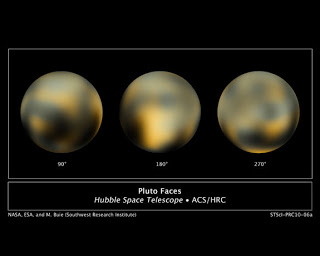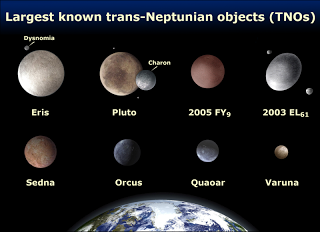Astronomy

Since Pluto is so far from Earth, little is known about the planet?s size or surface conditions. Pluto has an estimated diameter less than one-fifth that of Earth or only about two-thirds as wide as Earth's moon. The planets? surface conditions probably consist of a rocky core surrounded by a mantle of water ice, with more exotic ices such as methane and nitrogen frost coating its surface.
Pluto's orbit is highly eccentric, or far from circular, which means its distance from the sun can vary considerably and at times, Pluto?s orbit will take within the orbit of the planet Neptune. When Pluto is closer to the sun, its surface ices thaw and temporarily form a thin atmosphere, mostly of nitrogen, with some methane. Pluto's low gravity, which is a little more than one-twentieth that of Earth's, causes this atmosphere to extend much higher in altitude than Earth's. When traveling farther away from the Sun, most of Pluto's atmosphere is thought to freeze and all but disappear. Still, in the time that it does have an atmosphere, Pluto can apparently experience strong winds.Pluto's surface is one of the coldest places in the solar system at roughly minus 375 degrees F (minus 225 degrees C). For a long time, astronomers knew little about its surface because of its distance from Earth, but more is coming, bit by bit, with the Hubble Space Telescope returning images of a planet that appears reddish, yellowish and grayish in places, with a curious bright spot near the equator that might be rich in carbon monoxide frost. When compared with past images, the Hubble pictures revealed that Pluto had apparently grown redder over time, apparently due to seasonal changes.
Pluto's Moons :

The innermost moon, Charon, was discovered by James Christy on June 22, 1978.
Pluto and Charon are just 12,200 miles (19,640 kilometers) apart, less than the distance by flight between London and Sydney. Charon's orbit around Pluto takes 6.4 Earth days, and one Pluto rotation ? a Pluto day ? also takes 6.4 Earth days. This is because Charon hovers over the same spot on Pluto's surface, and the same side of Charon always faces Pluto, a phenomenon known as tidal locking.While Pluto appears reddish, Charon seems grayish. Scientists suggest Pluto is covered with nitrogen and methane while Charon is covered with ordinary water ice.Compared with most of solar system's planets and moons, the Pluto-Charon system is tipped on its side in relation to the sun. Also, Pluto's rotation is retrograde compared to the other worlds ? it spins backwards, from east to west
In 2005, as scientists photographed Pluto with the Hubble Space Telescope in preparation for the New Horizons mission ? the first spacecraft to visit Pluto and the Kuiper Belt ? they discovered two other tiny moons of Pluto, now dubbed Nix and Hydra. These are two to three times farther away from Pluto than Charon, and they are thought to be just 31 to 62 miles (50 to 100 kilometers) wide.
Scientists using Hubble discovered a fourth moon in 2011. This moon is estimated to be 8 to 21 miles (13 to 34 km) in diameter. P4's orbit is between the orbits of Nix and Hydra. On July 11, 2012, a fifth moon was discovered P5.


Pluto has been demoted because it does not dominate its neighborhood. Charon, its large "moon," is only about half the size of Pluto, while all the true planets are far larger than their moons.
In addition, bodies that dominate their neighborhoods, "sweep up" asteroids, comets, and other debris, clearing a path along their orbits. By contrast, Pluto's orbit is somewhat untidy.
Any object that doesn?t meet this 3rd criteria is considered a dwarf planet. And so, Pluto is a dwarf planet. There are still many objects with similar size and mass to Pluto jostling around in its orbit. And until Pluto crashes into many of them and gains mass, it will remain a dwarf planet. Eris suffers from the same problem.
- Sky Watching Dec 18 - 25
Sky Watching 2012,December,18-25 Tue., December 18, 4 a.m. Ceres at opposition...
- Do You Know - 3
Do You Know? - 3 1 . What is the name of the 2nd biggest planet in our solar system? Ans: Saturn ...
- Picture Of The Day Oct - 25
Picture Of The Day October 25 , Thursday The Cone Nebula (NGC 2264) ...
- Picture Of The Day
Picture Of The Day October 17, Wednesday ...
- Astronomy Quiz
Do You Know? 1. What is the brightest star in the night sky at any time? ...
Astronomy
Pluto
Pluto

Mass : (1.305 ± 0.007)×1022 kg
Equatorial surface gravity : 0.658 m/s2
Mean distance from the Sun (km) : 5,913,520,000
Sidereal rotation period : 6 d 9 h 17 m 36 s
Orbital period (years) : 248.54
Discovered : Clyde W. Tombaugh
Discovery date : February 18, 1930
Pluto is the only dwarf planet to once have been considered a major planet. Once thought of as the ninth planet and the one most distant from the sun, Pluto is now seen as one of the largest known members of the Kuiper Belt, a shadowy disk-like zone beyond the orbit of Neptune populated by a trillion or more comets. Pluto was reclassified as a dwarf planet in 2006 . American astronomer Percival Lowell first caught hints of Pluto's existence in 1905 from odd deviations he observed in the orbits of Neptune and Uranus, suggesting that another world's gravity was tugging at them from beyond. He predicted its location in 1915, but died without finding it. Its discovery came in 1930 from Clyde Tombaugh at the Lowell Observatory, based on predictions from Lowell and other astronomers.Pluto is the only world named by an 11-year-old girl, Venetia Burney of Oxford, England, who suggested to her grandfather that it get its name from the Roman god of the underworld. Her grandfather then passed the name on to Lowell Observatory. The name also honors Percival Lowell, whose initials are the first two letters of Pluto.
Pluto's orbit is highly eccentric, or far from circular, which means its distance from the sun can vary considerably and at times, Pluto?s orbit will take within the orbit of the planet Neptune. When Pluto is closer to the sun, its surface ices thaw and temporarily form a thin atmosphere, mostly of nitrogen, with some methane. Pluto's low gravity, which is a little more than one-twentieth that of Earth's, causes this atmosphere to extend much higher in altitude than Earth's. When traveling farther away from the Sun, most of Pluto's atmosphere is thought to freeze and all but disappear. Still, in the time that it does have an atmosphere, Pluto can apparently experience strong winds.Pluto's surface is one of the coldest places in the solar system at roughly minus 375 degrees F (minus 225 degrees C). For a long time, astronomers knew little about its surface because of its distance from Earth, but more is coming, bit by bit, with the Hubble Space Telescope returning images of a planet that appears reddish, yellowish and grayish in places, with a curious bright spot near the equator that might be rich in carbon monoxide frost. When compared with past images, the Hubble pictures revealed that Pluto had apparently grown redder over time, apparently due to seasonal changes.
Pluto's Moons :

Pluto and Charon are just 12,200 miles (19,640 kilometers) apart, less than the distance by flight between London and Sydney. Charon's orbit around Pluto takes 6.4 Earth days, and one Pluto rotation ? a Pluto day ? also takes 6.4 Earth days. This is because Charon hovers over the same spot on Pluto's surface, and the same side of Charon always faces Pluto, a phenomenon known as tidal locking.While Pluto appears reddish, Charon seems grayish. Scientists suggest Pluto is covered with nitrogen and methane while Charon is covered with ordinary water ice.Compared with most of solar system's planets and moons, the Pluto-Charon system is tipped on its side in relation to the sun. Also, Pluto's rotation is retrograde compared to the other worlds ? it spins backwards, from east to west
In 2005, as scientists photographed Pluto with the Hubble Space Telescope in preparation for the New Horizons mission ? the first spacecraft to visit Pluto and the Kuiper Belt ? they discovered two other tiny moons of Pluto, now dubbed Nix and Hydra. These are two to three times farther away from Pluto than Charon, and they are thought to be just 31 to 62 miles (50 to 100 kilometers) wide.
Scientists using Hubble discovered a fourth moon in 2011. This moon is estimated to be 8 to 21 miles (13 to 34 km) in diameter. P4's orbit is between the orbits of Nix and Hydra. On July 11, 2012, a fifth moon was discovered P5.
Exploration:

NASA's New Horizons mission will be the first probe to study Pluto, its moons, and other worlds within the Kuiper Belt. It was launched on January 2006, making its closest approach to Pluto on July 2015, and carries some of the ashes of Pluto's discoverer, Clyde Tombaugh.
Why Pluto is No Longer a Planet

For an object to be a planet, it needs to meet these three requirements defined by the IAU:
- It needs to be in orbit around the Sun ? Yes, so maybe Pluto is a planet.
- It needs to have enough gravity to pull itself into a spherical shape ? Pluto?check
- It needs to have ?cleared the neighborhood? of its orbit ? Uh oh. Here?s the rule breaker. According to this, Pluto is not a planet.
Pluto has been demoted because it does not dominate its neighborhood. Charon, its large "moon," is only about half the size of Pluto, while all the true planets are far larger than their moons.
In addition, bodies that dominate their neighborhoods, "sweep up" asteroids, comets, and other debris, clearing a path along their orbits. By contrast, Pluto's orbit is somewhat untidy.
Any object that doesn?t meet this 3rd criteria is considered a dwarf planet. And so, Pluto is a dwarf planet. There are still many objects with similar size and mass to Pluto jostling around in its orbit. And until Pluto crashes into many of them and gains mass, it will remain a dwarf planet. Eris suffers from the same problem.
- Sky Watching Dec 18 - 25
Sky Watching 2012,December,18-25 Tue., December 18, 4 a.m. Ceres at opposition...
- Do You Know - 3
Do You Know? - 3 1 . What is the name of the 2nd biggest planet in our solar system? Ans: Saturn ...
- Picture Of The Day Oct - 25
Picture Of The Day October 25 , Thursday The Cone Nebula (NGC 2264) ...
- Picture Of The Day
Picture Of The Day October 17, Wednesday ...
- Astronomy Quiz
Do You Know? 1. What is the brightest star in the night sky at any time? ...
